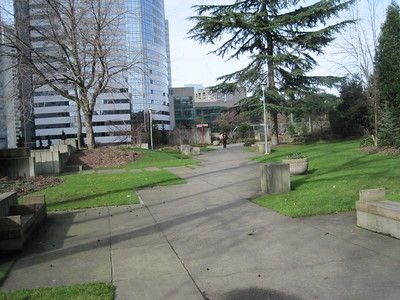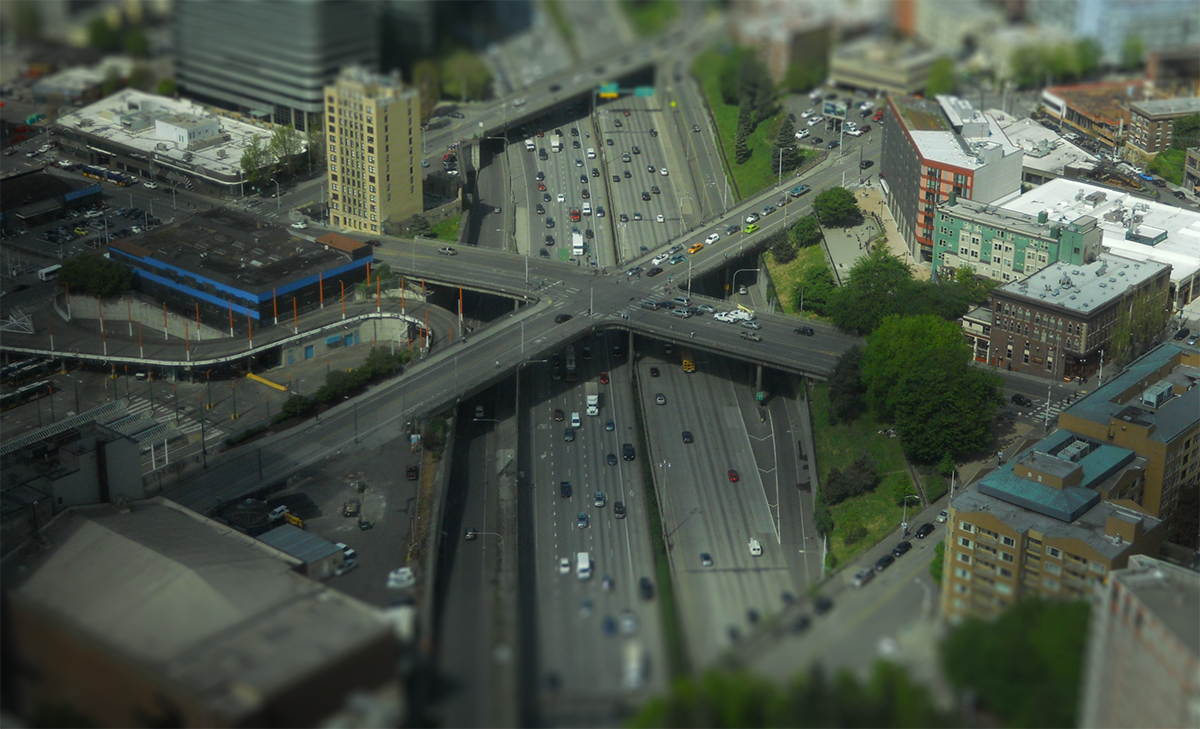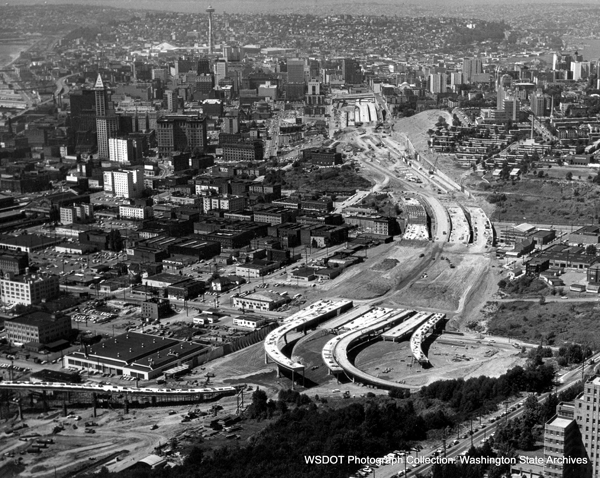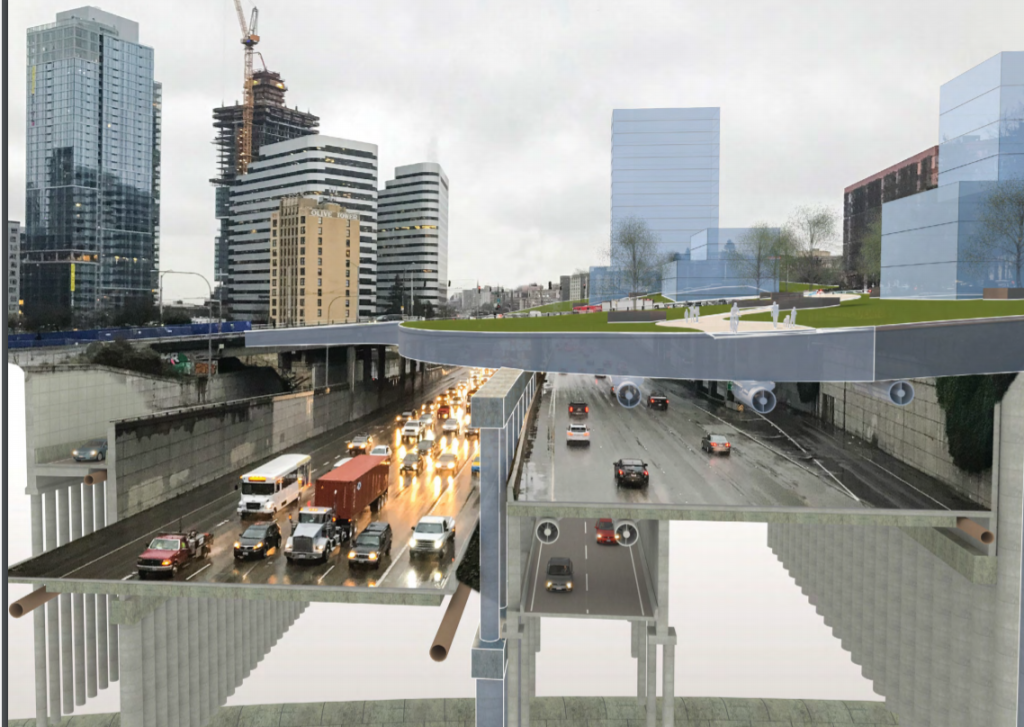A Seattle stretch of I-5 is one of the “Freeways Without Futures” listed in seventh annual report from the Congress for New Urbanism (CNU), which profiles 15 freeways across the nation identified as serial offenders ripe for removal or reinvention. Recent progress made by the Lid I-5 campaign played a major role in the selection of I-5 for the report.
Early on, Seattle pioneered a new way of thinking about the relationship between city and freeway with the construction of Freeway Park over I-5 in downtown. Today, the highway is overdue for safety upgrades, including earthquake retrofitting, presenting the perfect opportunity to expand this lid and better serve people, not just cars. The Lid I-5 movement seeks to build on Freeway Park’s legacy and spark a citywide conversation about what can be done with highways that damage communities.
From “Freeways Without Futures 2021,” by the Congress for New Urbanism (CNU)
The publication of “Freeways Without Futures” corresponds perfectly with an important moment in Seattle’s past. On June 1st, 1961, protesters marched along the proposed route for I-5 carrying signs that read “Block the Ditch” and “Let’s Have a Lid on It.” While the battle to prevent the proposed route for I-5 from cutting through the center of the city had already been lost, city residents still hoped to halt plans for an open freeway trench dividing Capitol Hill and First Hill from Downtown Seattle. Their preferred option? Covering the freeway with a lid that would provide safe pedestrian connections into Downtown while suppressing some noise and air pollution from passing vehicles.

Among the protesters was architect Paul Thiry, a First Hill resident and supervising architect of Seattle’s 1962 World’s Fair. Earlier in 1961, Thiry stepped down from the Seattle Planning Commission because of his opposition to the freeway plans, and now he marched in the hope that what he saw as a fatal city planning error could be at least partly remedied by lidding two segments of the freeway: Madison to University Street and Pike Street to Olive Way.
While Thiry’s advocacy would lead to the construction of 5.5 acre Freeway Park, sixty years later in 2021, his vision for a connected city center for Seattle remains largely unrealized. That’s where the Lid I-5 campaign has entered the stage.

17 Acres of New Land in Downtown Seattle
Last year a feasibility study completed for the City of Seattle confirmed that lidding the freeway in the study area, which extends from Madison Street to Denny Way, was technically feasible and publicly desirable.
The study determined up to 17 acres of land could be created for public and/or private use, with a wide mix of possible scenarios including up to 10 acres of new public parks, 500 on-site affordable housing units, reconnected city streets for people walking and bicycling, or millions of square feet of private development. The environmental benefits would be significant, and the project could generate up to $3 billion in annual economic activity for the region.
Lid I-5 Campaign Press Release, 2021
Rather than advocating for a specific use for the new land created by lidding I-5, the campaign advocates for the master plan for the project to be created with deep and equitable public engagement. As a precursor to future public engagement efforts, Lid I-5 has been conducting its own polling. A recent survey of about 70 participants indicated strong support for using the lid to create public amenities like parks, schools, and walking and biking connections. Overall, participants indicated a strong preference for green space, expressing desire for the lid to provide space for urban gardens, green infrastructure, affordable housing, and other solutions for environmental and noise pollution rather than commercial buildings.
An advanced engineering study and more comprehensive public engagement are key next steps for advancing the project; however, both are currently unfunded. Additionally, recent action taken by the Washington State legislature in its 2021-2023 operating budget expressly prohibits spending funds to position I-5 for a state of good repair, earthquake resilience, multimodal mobility and safety, and lidding the freeway. This move potentially jeopardizes access to billions of dollars in federal funding proposed in the American Jobs Plan for reconnection projects in urban neighborhoods divided by freeways.
The legislature’s decision came despite the fact that Washington State Department of Transportation (WSDOT) has long acknowledged the need to retrofit and repair 1-5’s aging infrastructure. According to 2018 report published by the Puget Sound Regional Council (PSRC), the state is posed to spend billions on preserving I-5 through 2040. Even so, the state has failed to provide funding for I-5 planning projects, including the I-5 System’s Partnership, whose 2018 report was a rallying cry for the need to reimagine the largest and most heavily trafficked road in the state. Unfortunately, WSDOT did not receive the federal or state funds to continue with effort and the I-5 Systems Partnership was put on hold.
Unless the State begins investing in reimagining the future of I-5, it seems all but certain that future will look a lot like the present — except worse, since traffic, pollution, and ongoing maintenance expenses seem unlikely to decrease or even level off in the coming years. Investing in planning the future of I-5, including seriously examining solutions like lidding the freeway in areas where it makes sense, could help forge the way toward a more equitable, environmentally resilient, and fiscally responsible transportation future.
Natalie Bicknell is a member of the Lid I-5 Steering Committee.
Natalie Bicknell Argerious (she/her) is a reporter and podcast host at The Urbanist. She previously served as managing editor. A passionate urban explorer since childhood, she loves learning how to make cities more inclusive, vibrant, and environmentally resilient. You can often find her wandering around Seattle's Central District and Capitol Hill with her dogs and cat. Email her at natalie [at] theurbanist [dot] org.





